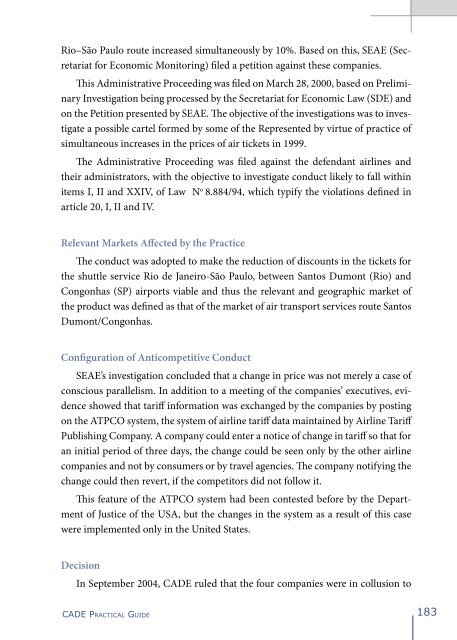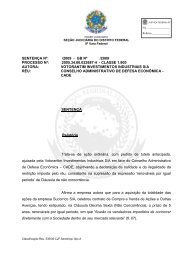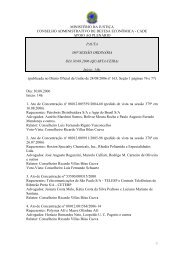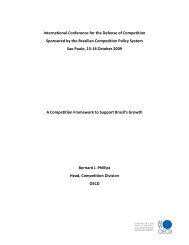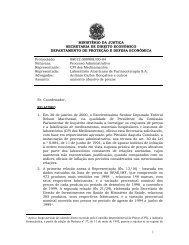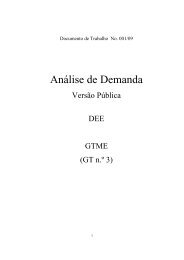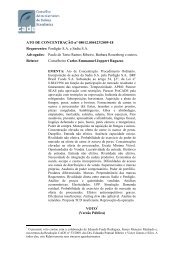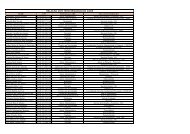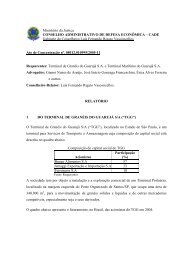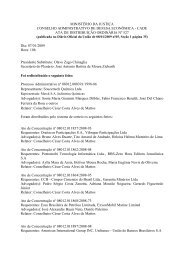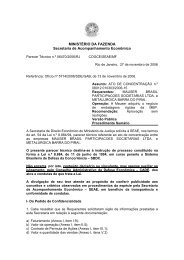- Page 2:
CONSELHO ADMINISTRATIVODE DEFESA EC
- Page 5:
ÍNDICEINTRODUÇÃOCatalog Record71
- Page 10 and 11:
3. Por que o monopólio pode ser pr
- Page 12 and 13:
por parte de empresas ou de seus ad
- Page 14 and 15:
executar a política nacional de pr
- Page 16 and 17:
Coordenação-Geral de Comunicaçã
- Page 18 and 19:
Cada um dos membros do Plenário te
- Page 20 and 21:
15. A que corresponde o papel educa
- Page 23 and 24:
Conceitos jurídico-econômicosenvo
- Page 25 and 26:
5. Quando a empresa tem participaç
- Page 27 and 28:
Conceitos legais legais envolvidos
- Page 29 and 30:
de uma denúncia ou até mesmo por
- Page 31 and 32:
Apresentação e análise e anális
- Page 33 and 34:
Análise de condutas de condutas le
- Page 35 and 36:
apuração dos fatos, sendo este ex
- Page 37 and 38:
um ilícito per se, devendo ser ava
- Page 39:
16. O que é discriminação de pre
- Page 42 and 43:
plo poder de disseminação de info
- Page 45 and 46:
CASOS PRÁTICOSAtos de concentraç
- Page 47 and 48:
levantar preocupações do CADE em
- Page 49 and 50:
exclusividade aos pontos de venda (
- Page 51 and 52:
2. CASO NESTLÉ / GAROTOAto de Conc
- Page 53 and 54:
ESTRUTURA DE OFERTA NO MERCADO DE C
- Page 55 and 56:
decisão do CADE, tendo conseguido
- Page 57 and 58:
Estrada de Ferro Vitória Minas (EF
- Page 59 and 60:
Adicionalmente a estas determinaç
- Page 61 and 62:
no mercado de cristais de insulina
- Page 63 and 64:
PROCESSOS ADMINISTRATIVOS1. CASO DO
- Page 65 and 66:
O pós-decisãoAs representadas aju
- Page 67 and 68:
de programas como o SISCO 11 e o PA
- Page 69 and 70:
sentença judicial.Relativamente à
- Page 71 and 72:
não cobertos pela “box rate” 1
- Page 73 and 74:
Em relação à Microsoft, foram as
- Page 75 and 76:
Microsoft, ao criar uma posição e
- Page 77 and 78:
Descrição do casoEm agosto de 199
- Page 79 and 80:
LEI DE DEFESA DA CONCORRÊNCIALei n
- Page 81 and 82:
sem prejuízo de suas atribuições
- Page 83 and 84:
Público Federal;XV - determinar à
- Page 85 and 86:
VI - zelar pelo cumprimento desta l
- Page 87 and 88:
XIV - desenvolver estudos e pesquis
- Page 89 and 90:
VII - exigir ou conceder exclusivid
- Page 91 and 92:
III - No caso das demais pessoas f
- Page 93 and 94:
CAPÍTULO IVDA PRESCRIÇÃOArtigo 2
- Page 95 and 96:
Artigo 35. Decorrido o prazo de apr
- Page 97 and 98:
§ 7º A empresa ou pessoa física
- Page 99 and 100:
com antecedência mínima de cinco
- Page 101 and 102:
não poderá ser inferior ao mínim
- Page 103 and 104:
§ 9º Se os atos especificados nes
- Page 105 and 106:
Artigo 62. Na execução que tenha
- Page 107 and 108:
§ 1º Se, apesar das providências
- Page 109 and 110:
Artigo 85. O inciso VII do art. 4º
- Page 111 and 112:
Notas1 Nota: Parágrafo único orig
- Page 113 and 114:
“Parágrafo único. Não justific
- Page 115 and 116:
estabelecido; b) valor da multa di
- Page 117 and 118:
dente da República submeterá à a
- Page 119:
PARA SABER MAISCADEConselho Adminis
- Page 123 and 124:
PRACTICAL GUIDEThe Importance of Co
- Page 125:
5. How is competition dealt with by
- Page 128 and 129:
ute towards the adoption of procedu
- Page 130 and 131:
opinions about the effects of opera
- Page 132 and 133: terations, which appear as merger r
- Page 134 and 135: 18. What is the role of the Federal
- Page 136 and 137: 3. When does a dominant position oc
- Page 139 and 140: LegalLegal ConceptsConceptsInvolved
- Page 141 and 142: If SDE concludes, during the prelim
- Page 143 and 144: SubmittingSubmitting andandAnalyzin
- Page 145 and 146: Analysis of Conducts Harmful toComp
- Page 147 and 148: the edition of Law Nº 10.149 of De
- Page 149 and 150: 13. What are exclusivity agreements
- Page 151 and 152: PromotingPromoting the Defensethe D
- Page 153: 5. Does the student receive any fin
- Page 156 and 157: TABLE 1AMBEV - DISTRIBUTION OF ORDI
- Page 158 and 159: Therefore, the high market concentr
- Page 160 and 161: ucts was lower than that of the gen
- Page 162 and 163: SUPPLY STRUCTURE IN THE MARKET OF C
- Page 164 and 165: 3. VALE DO RIO DOCE CASEMerger Revi
- Page 166 and 167: Problems FoundWith the operations,
- Page 168 and 169: 4. INSULIN CASEMerger Review nº 08
- Page 170 and 171: DecisionThe operation was approved
- Page 172 and 173: entry barriers, virtually identical
- Page 174 and 175: Relevant Market Affected by the Pra
- Page 176 and 177: ommended public agencies not to acc
- Page 178 and 179: (iii) the value charged corresponds
- Page 180 and 181: pany in the market of distribution
- Page 184 and 185: increase tariffs. Among other penal
- Page 186 and 187: TITLE IITHE ADMINISTRATIVE COUNCIL
- Page 188 and 189: with this Law;XI - commission the c
- Page 190 and 191: Paragraph 3. In the event of absenc
- Page 192 and 193: CHAPTER IIVIOLATIONSArticle 20. Sha
- Page 194 and 195: 194CHAPTER IIIPENALTIESArticle 23.
- Page 196 and 197: CHAPTER VCAUSE OF ACTIONArticle 29.
- Page 198 and 199: 198ded for in the opening paragraph
- Page 200 and 201: its final arguments within five day
- Page 202 and 203: III - The fixing of the value of th
- Page 204 and 205: the Securities Commission - CVM and
- Page 206 and 207: Article 67. Daily fines on an ongoi
- Page 208 and 209: Article 81-A. The Administrative Co
- Page 211 and 212: Notes1 Note: Sole Paragraph renumbe
- Page 213 and 214: 15 Note: Transcription of the passa
- Page 215 and 216: Unit), or a new reference unit. Bac
- Page 217 and 218: It is apparent that the innovations
- Page 219: FURTHER INFORMATIONhttp://www.CADE.
- Page 222 and 223: COLEÇÃO CIEEColeção CIEE-01 (es
- Page 224 and 225: COLEÇÃO CIEEColeção CIEE-69 (es
- Page 226 and 227: CONSELHO DE ADMINISTRAÇÃO(Mandato
- Page 228: Editado numa parceria CIEE/CADE, o


